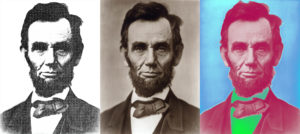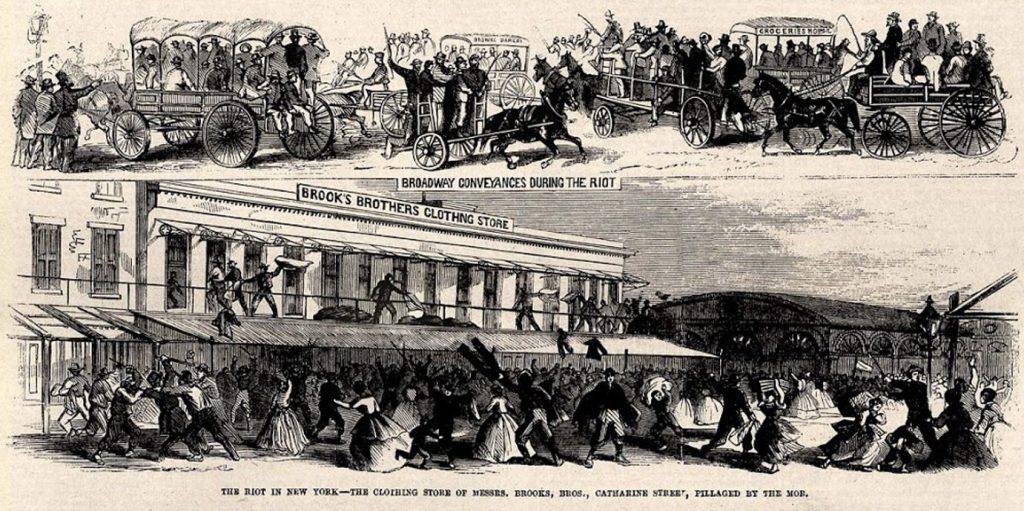Imitative Lincoln: Art Derived from Photos

Come see the newest exhibition, “Imitative Lincoln: Art Derived from Photographs.” Focusing on the ways artists have recreated Lincoln’s likeness from the photographs he sat for in his life, the exhibit will include a wide range of artistic techniques, from 19th century engravings to modern day mosaics, demonstrating how Lincoln has inspired artists over time. See the exhibit.
Lincoln Dinner Sponsorship

The Lincoln Dinner Sponsorship Fund has aided in the acquisition of several wonderful additions to the Shrine’s collections that are unveiled at the Watchorn Lincoln Dinner each year. Thanks to the generosity of sponsors to the 2023 Watchorn Lincoln Dinner, the Shrine acquired a fascinating letter written by Abraham Lincoln to then-Secretary of the Treasury, Salmon P. Chase, in 1864. Writing on his birthday about allegations of corruption by Hiram Barney in the Port of New York, the letter is an example of the tense relationship between Lincoln and Chase at a critical time in his presidency.
Learn more about this new acquisition.
Secrets of a Civil War Photo Album
 A Civil War photo album donated by a local family a few years ago came with an interesting story. Featuring more than two dozen men of the 21st Connecticut Infantry regiment, the album was created by the regiment’s Captain E. Perry Packer. Captain Packer and his family moved to Santa Monica, California in the 1870s and assumed new identities. Why did they make such a drastic move? Who were the men included in the photo album?
A Civil War photo album donated by a local family a few years ago came with an interesting story. Featuring more than two dozen men of the 21st Connecticut Infantry regiment, the album was created by the regiment’s Captain E. Perry Packer. Captain Packer and his family moved to Santa Monica, California in the 1870s and assumed new identities. Why did they make such a drastic move? Who were the men included in the photo album?
Discover the stories uncovered in the Packer family Civil War photo album.
Lincoln in Plaster, Marble, and Bronze
Sculpture from the Permanent Collection
Explore “Lincoln in Plaster, Marble, and Bronze”

Abraham Lincoln first sat for sculptor Leonard Volk in the spring of 1860, before he was even nominated for President. Volk created a plaster “life mask” of Lincoln’s face in order to reduce the number of sittings. Nearly every sculptor during the following 160 years has utilized this and a second life mask, created by Clark Mills in 1865.
In these artistic creations, Lincoln is presented in myriad ways: noble, determined, rugged, stoic, and heroic. The forms the artists used include realism, idealization, and abstraction. Lincoln’s enduring legacy is not only his achievements during his lifetime, but also how his visage continues to be created, shaped, and presented through artistic expression.
US Sanitary Commission

Concerned about the welfare of their family members in the military, citizens in the North created several private organizations designed to improve their living conditions. Among the most effective was the United States Sanitary Commission, which worked with field hospitals and camps, and provided food and medical care to soldiers returning from the war. The group hosted Sanitary Fairs in Northern and Midwestern cities to raise fund for their efforts during the war. President Lincoln and his wife Mary visited Sanitary Fairs in and around Washington, D.C. to congratulate members of the Commission for their work. (Learn more about the Lincolns visit to a fair in April, 1864).
It was at a Sanitary Fair in Connecticut that the story of the Shrine’s Sanitary Commission quilt begins. Learn more about the quilt’s history.
Clara Barton’s Missing Soldiers Office

Among her many accomplishments, Clara Barton spent the post-Civil War years working with families to locate missing soldiers. Headed by Barton, the Office of Correspondence with Friends of the Missing Men of the United States Army, known as the Missing Soldiers Office, corresponded with tens of thousands of families between 1865 and 1868.
P.A. Bell: Abolitionist

Have you heard of abolitionist journalist Philip Alexander Bell? A native of New York, Bell was active in New York City’s African American community before moving west and founding The Elevator, a newspaper that became an important voice for San Francisco’s African American community in the period following the Civil War.
Learn more about Bell’s remarkable accomplishments.
Camp Life of a Soldier
How did soldiers spend their days at camp?

Fraught with boredom, mischief, and disease, Civil War army camps were often a den of malice. With the average soldier spending three quarters of his time at camp, most were forced to find ways to alleviate the monotony of their daily routine. While gambling was considered an “evil practice,” card games, dice, marbles, and lice races were common distractions. Combined with the periodic consumption of alcohol, boredom and gaming often led to physical altercations between soldiers.
Slavery Shall Not Exist in the United States

Since its founding, anti-slavery sentiment existed in the United States. As the nation expanded, boundaries shifted and the population increased, creating a larger divide between citizens. This divide grew as the abolitionist movement became prevalent in the northern states, while the southern states continued to exploit the enslaved populations as a labor source. This unsteady arrangement created political and social tension throughout the country. Learn more about the journey to end slavery in the United States.
Edward Baker, California Martyr

Oregon Senator Edward D. Baker became the only member of the Senate to die in battle during the Civil War. His death at the Battle of Ball’s Bluff in October, 1861 made him a martyr in the fight to end the southern rebellion and brought heartache for his good friend Abraham Lincoln. Learn about Senator Baker’s remarkable life and his role in forming the California Regiment.
Lincoln and Mexico

Events in Mexico had a major impact on Abraham Lincoln’s career. In 1847, newly elected Congressman Lincoln was strongly opposed to America’s war with Mexico. He accused President James K. Polk of lying about one of the principal causes of the war, an alleged Mexican attack on US troops. Lincoln demanded to know the exact spot where the attack took place, believing that it was on Mexican soil, not American. Lincoln’s detractors derisively nicknamed him “spotty Lincoln”. Unfortunately for his congressional career, the war was very popular with the majority of his constituents in Illinois. As a result, Lincoln’s political party, the Whigs, declined to back him for reelection in 1848. Find out the rest of the story.
Thanks to You

To honor President Lincoln’s birthday, the Watchorn Lincoln Memorial Association hosts the annual Watchorn Lincoln Dinner each February 12th. The largest event of its kind in the United States, the Lincoln Dinner has become a great opportunity for supporters to make a contribution for the Shrine to acquire something new each year.
Since its inception in 2017, the Lincoln Sponsorship Fund has aided in the acquisition of wonderful additions to the Shrine’s collections. Explore the items acquired through the generosity of supporters of the Sponsorship Fund.
Medal of Honor Hero: Benjamin Hilliker

An eighteen year old drummer boy in the 8th Wisconsin Infantry, Benjamin Hilliker was awarded our nation’s highest military decoration for his heroism during the decisive Vicksburg campaign. Learn the story of his heroism.
The Sultana Disaster
Learn about the worst maritime disaster in American history and its part in the Civil War.
Learn about the “The Sultana Disaster”.

Enlisting Lincoln

Abraham Lincoln’s likeness and words were used for a variety of purposes since his untimely death at the age of 56. This has particularly been true during moments of turmoil in the United States. World War I is an example of a time when leaders turned to the 16th President to inspire the public.
See how Lincoln played a role during the Great War.
Dorothea Dix: Dictator in a Petticoat

Educator, social reformer, and humanitarian Dorothea Dix devoted her life to advocating for the mentally ill. Her tireless work to bring attention to the often overlooked and misunderstood issue brought about widespread reforms in the field in the United States and abroad. During the Civil War, Dix was charged with the administration of military hospitals where she advocated for the work of female nurses. Learn more about Dorothea Dix’s work during the Civil War.
First Louisiana Native Guard

The original First Louisiana Native Guard was formed as part of the Louisiana militia in May 1861. Composed of former slaves who had escaped to freedom and free black men, some of whom held prominent positions in New Orleans society in the antebellum period, the group was disbanded in early 1862 and never mustered in to the Confederate military.
Find out why the short-lived militia group has become a source on controversy.
1860 Election

The significance of the Presidential Election of 1860 is indisputable. The four way contest pitted Republican Abraham Lincoln against Democrat Senator Stephen Douglass, Southern Democrat John Breckinridge, and Constitutional Unionist John Bell. The outcome sparked Civil War and irrevocably changed the nation. Learn more about the most important election in American history.
Veterans Go West

Some had streets named after them, others played prominent roles in the establishment and promotion of the City of Redlands in its early years, but they all shared the experience of having served in the military during the Civil War. As was true of many western cities, Redlands was settled by hundreds of Civil War veterans in its formative years. While the majority merely passed through town for brief periods, others made Redlands their home and the place where they lived the remainder of their lives.
Learn about Relands’s Civil War veteran’s efforts to commemorate their wartime experiences.
New York City Draft Riots

By the beginning of 1863 enthusiasm in the North for what many were calling “Mr. Lincoln’s war” was fading. Thousands of soldiers had deserted and many volunteers were reaching the end of their two year enlistment terms. Desperate for more men to prosecute the war, Lincoln decided to push forward a conscription act, which would force men into the military. Learn about the consequences of this decision.
Remember Fort Pillow

Overlooking the Mississippi River, Fort Pillow was constructed in under the direction of Confederate Brigadier General Gideon Pillow in 1861. Captured by United States forces the following year, the river stronghold became a supply depot and recruitment center. Learn about the tragedy that made “Remember Fort Pillow!” the battle cry of African American soldiers.
Lincoln the Lawyer

Abraham Lincoln practiced law for nearly twenty-five years in Illinois. Other than part-time service in the Illinois legislature and United States Congress, law was his full-time occupation prior to the presidency. Learn more about Lincoln’s career as a lawyer.
Interactive Displays
Now open!
 Take a picture with Lincoln!
Take a picture with Lincoln!

Try the telegraph! The latest in 1860s technology.
Lincoln Family Tree
Ever wondered if there are any living descendants of Abraham Lincoln? Find the answer on the Lincoln Family Tree.

And the War Came




